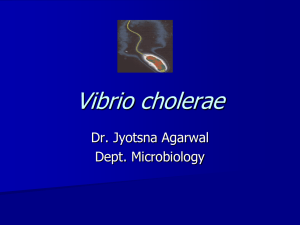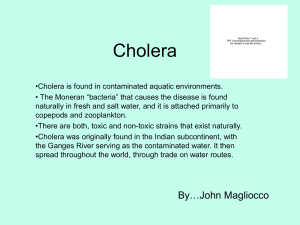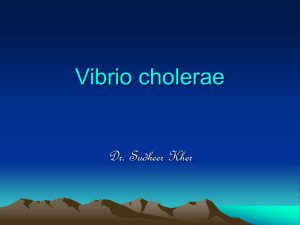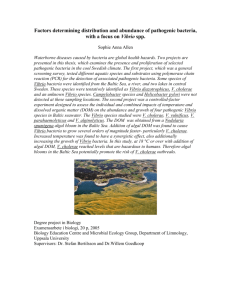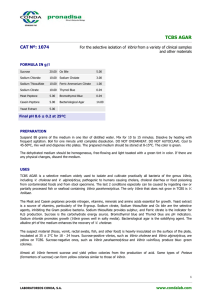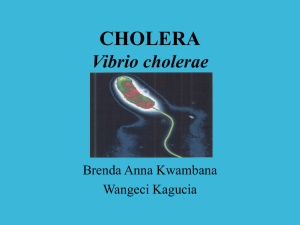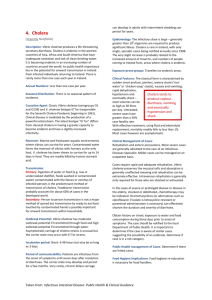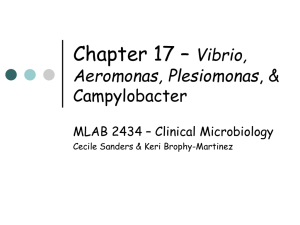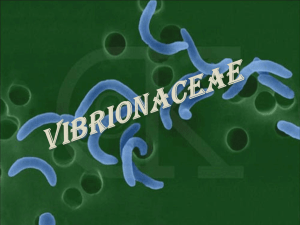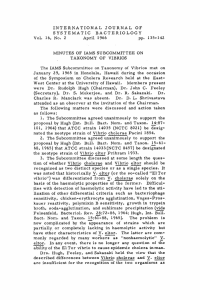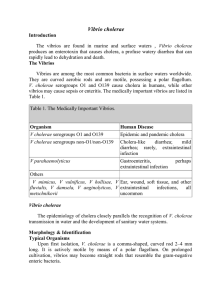Gram negative rods
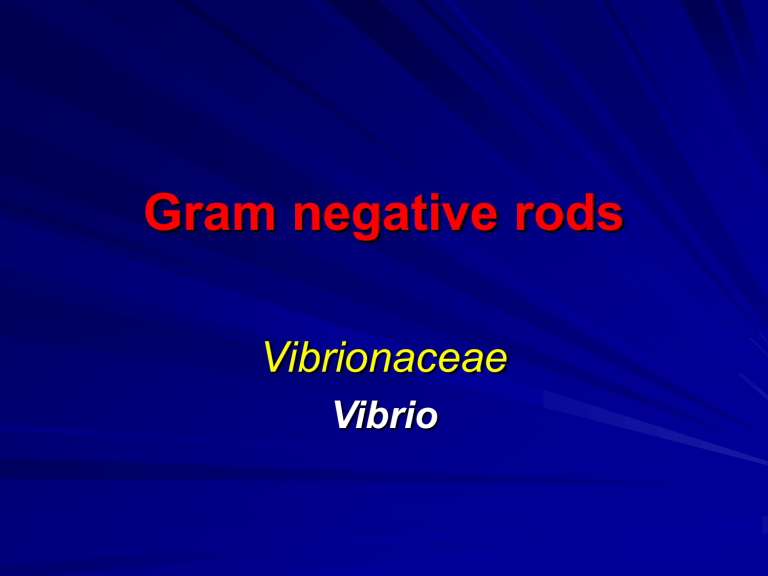
Gram negative rods
Vibrionaceae
Vibrio
General charcters of Vibrionaceae
Gram negative, curved, comma shaped bacilli
Motile by single polar flagella
Non spore forming
Non capsulated
Most vibrios have relatively simple growth factor requirements and grow well in alkaline pH
Facultative anaerobes
Vibrios are capable of both respiratory & fermentative metabolism i.e. O+/F+.
Oxidase and catalase positive
Natural inhabitants of aquatic environment
Species of Vibrio
Vibrios
Classical type
V. cholerae
Vibrio cholerae
Cause Cholera
V. parahaemolyticus cause
Gastroenteritis
Allied vibrios
Saprophytic
El-Tor-type
V. El-Tor
Species of Vibrio
V. cholerae is the causative agent of cholera
– V. cholerae divided serologically into 6 groups based on somatic O-antigens
– V. cholerae O1 and O139 are the most important agents that cause cholera
– V. El-Tor is O1 serotype that cause disease similar to cholera but milder
Vibrio parahaemolyticus is the cause of acute gastroenteritis following ingestion of contaminated sea-food such as raw fish
V. cholerae & V. parahaemolyticus, are pathogens of human, produce diarrhea, but in ways those are entirely different.
– V. parahaemolyticus is an invasive organism affecting the colon
– V. cholerae is noninvasive , affecting the small intestine through secretion of an enterotoxin.
Allied Vibrios are a large group of organisms; some of them are saprophytic while others cause disease in animals
Difference between O1 V. choleae
Classical & El-Tor type
V. cholera e Vibrio El-Tor
Hemolysis Non hemolytic Hemolytic
Voges-
Prosakauer
Polymyxin B resistance
Negative
Sensitive
Positive
Resistant
Cholera
Cholera is toxin mediated, a severe diarrheal disease caused by V. cholerae O1 & 139 serotype and others .
It is endemic in southern Asia (India, Pakistan, and Bangladesh).
Transmission is by contaminated water or food through oral-fecal routs.
Incubation period of the disease is 1-4 days.
Sudden onset of intense vomiting and rice water diarrhea with rapid dehydration .
The disease progresses from the first liquid stool to shock in 4-12 hours, with death following in 18 hours to several days.
Identification of V. cholerae
Specimen and microscopical examination:
– Rice watery stool or rectal swap collected in acute stage of disease
– Dark-field microscopy of stool specimen from patients with cholera reveal large numbers of Vibrio (short, curved rods) with a characteristic motility that gives the appearance of shooting stars
Culture:
– Inoculation of rice water stool in enrichment media (alkaline peptone water, pH8.5), in which the organisms multiply rapidly and tend to form pellicle at the surface of the medium after 6-8 h at 37 C.
– Subculture is made into Thiosulphate Citrate Bile Sucrose (TCBS) agar.
Identification of V. cholerae
Principle
Growth on TCBS
TCBS medium is selective because
High conc. of thiosulfate and citrate & strong alkalinity of this medium (pH9)
Also, contains bile salts kills most intestinal commensals
TCBS medium is differential because
It contains sucrose
It contains bromothymol blue
Alkaline pH: blue
Neutral pH: green
Acidic pH: yellow
Some species ferment sucrose & others not ferment
Sucrose fermenting Vibrio spp ( V. cholerae ) appears as yellow colonies
Sucrose non fermenting Vibrio spp (V. parahemolyticus) appears as blue to green colonies
Sucrose fermentation on TCBS is the gold standard in its identification
Identification of Vibrio
Differentiation between SF & NSF by Growth on TCBS
Method:
– TCBS agar is inoculated with tested organism recovered from alkaline peptone water using streak plate technique
– Incubate the plate in incubator at 37 C/24 hrs
Results:
– SF organism appears as yellow colonies (V. cholerae)
– NSF organism appears as blue to green colonies ( V. parahaemolyticus )
Flame & Cool
1
5
2
3
4
Flame & Cool
Flame & Cool
Reaction on TCBS
Yellow colonies of V. cholorae due to sucrose fermentation
Identification of Vibrio cholreae
Gram stain:
Gram negative short rods, comma shaped, motile
Electron Micrograph of V cholerae
Rods with single polar flagella
Gram stain of Vibrio cholorae
Serology:
Diagnosis can be confirmed as well as serotyping done by agglutination with specific antisera (O1, O139 antisera)
